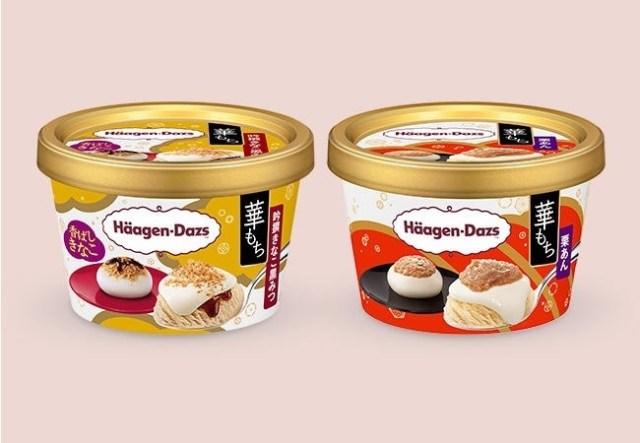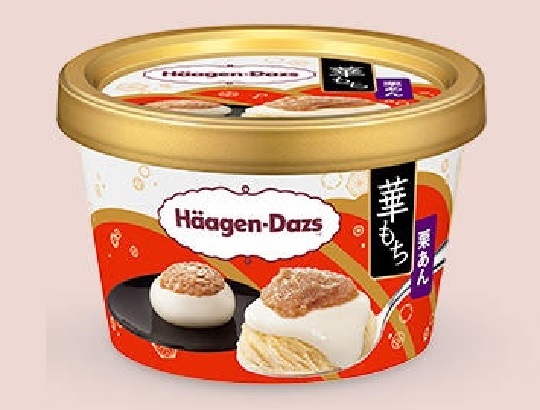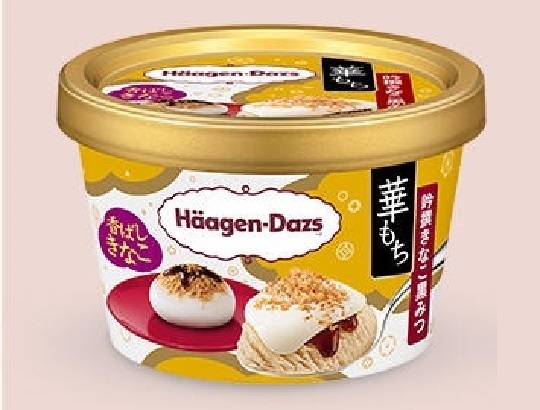
Ice cream maker rolls out two mochi-enhanced flavors we’re happy to dig into even after the weather gets cooler.
It’s natural to feel a twinge of sadness at the end of summer, as we transition from fun in the sun to longer, colder nights. Of course, the best way to shake off bittersweet feelings is with sweet desserts, and to that end Häagen-Dazs Japan is ready and willing to help.
Japanese foodies always appreciate it when seasonal ingredients are incorporated into a dish, and that goes for sweets too. So this month Häagen-Dazs is rolling out a brand-new flavor: chestnut sweet bean mochi.
If you’re going by the Japanese name, it’s the Hanamochi Kuri An, kuri being the Japanese word for “chestnuts,” which will be coming into season shortly as we get further into autumn. While most people think of the red version of anko (traditional Japanese sweet bean paste), Häagen-Dazs chestnut sweet bean mochi uses white anko, which has a slightly richer, less intensely sweet taste. Joining the white anko ice cream is chestnut sauce with a subtle hint of salt, added to help draw out more of the nut’s latent sweetness. And since this is part of the Hanamochi line, sitting atop the ice cream is a layer of chestnut anko mochi, lightly dusted with sugar, giving you all sorts of textures and flavors to enjoy.
Also set to grace supermarket and convenience store freezer cases is the Hanamochi Ginse Kinako Kuromitsu.
This isn’t an all-new flavor, as it’s been offered for limited times on multiple occasions in the past. Those encore appearances are proof, though, of how well kinako (roasted soybean powder, here made with a mix of yellow and black beans for a richer flavor and fragrance) works as an ice cream enhancer, especially when it’s backed up with kuromitsu, an old-school Japanese brown sugar syrup, and a mochi topping. Plus, since Häagen-Dazs likes to tinker with the exact ratio of ingredients, this year’s Ginse Kinako Kuromitsu might offer a slightly different experience than the one from years past.
Both flavors go on sale September 29, priced at 295 yen (US$2.75), and are excellent options for capping off a meal of other foods Japan loves to eat in the fall.
Source: Häagen-Dazs via Entabe
Images: Häagen-Dazs
● Want to hear about SoraNews24’s latest articles as soon as they’re published? Follow us on Facebook and Twitter!



 Häagen-Dazs Japan’s delicious mochi ice cream makes a comeback this fall
Häagen-Dazs Japan’s delicious mochi ice cream makes a comeback this fall Häagen-Dazs brings back its popular mochi ice cream line with two classic, luxurious flavors
Häagen-Dazs brings back its popular mochi ice cream line with two classic, luxurious flavors Häagen-Dazs’ beloved mochi ice cream is back with a new black sesame syrup flavor
Häagen-Dazs’ beloved mochi ice cream is back with a new black sesame syrup flavor Häagen-Dazs’ awesome mochi ice creams with black sugar syrup and sweet miso glaze are coming back
Häagen-Dazs’ awesome mochi ice creams with black sugar syrup and sweet miso glaze are coming back Häagen-Dazs releases new mochi ice cream, and it’s amazing! 【Taste test】
Häagen-Dazs releases new mochi ice cream, and it’s amazing! 【Taste test】 Japanese beef bowl chain Sukiya’s 2026 Smile Box lucky bag basically pays for itself
Japanese beef bowl chain Sukiya’s 2026 Smile Box lucky bag basically pays for itself Should you dip your cake in sake? One Japanese brewer says no, but actually yes【 Taste test】
Should you dip your cake in sake? One Japanese brewer says no, but actually yes【 Taste test】 Starbucks releases a colour-changing Frappuccino in Japan
Starbucks releases a colour-changing Frappuccino in Japan Hayao Miyazaki says Happy New Year to Studio Ghibli fans with new art for Year of the Horse
Hayao Miyazaki says Happy New Year to Studio Ghibli fans with new art for Year of the Horse Play games, learn, and get your fortune at Ginza’s limited-time Tsunaguu “Shrine of the Future”
Play games, learn, and get your fortune at Ginza’s limited-time Tsunaguu “Shrine of the Future” Welcome to Hell…Hell’s Dandan Noodles Tenryu in Kanagawa
Welcome to Hell…Hell’s Dandan Noodles Tenryu in Kanagawa Achingly beautiful video shows the simple joys of life in Japan’s Akita Prefecture 【Video】
Achingly beautiful video shows the simple joys of life in Japan’s Akita Prefecture 【Video】 Virtual pantie flash part of Japan’s new schoolgirl-inspired swimsuit’s sailor style【Photos】
Virtual pantie flash part of Japan’s new schoolgirl-inspired swimsuit’s sailor style【Photos】 7-Eleven’s edible cat paw proves Japanese convenience store sweets are on a whole other level
7-Eleven’s edible cat paw proves Japanese convenience store sweets are on a whole other level Starbucks on a Shinkansen bullet train platform: 6 tips for using the automated store in Japan
Starbucks on a Shinkansen bullet train platform: 6 tips for using the automated store in Japan Starbucks Japan ready to get Year of the Horse started with adorable drinkware and plushies【Pics】
Starbucks Japan ready to get Year of the Horse started with adorable drinkware and plushies【Pics】 7 great places to see Mt. Fuji from without having to climb it
7 great places to see Mt. Fuji from without having to climb it We found possibly the quietest Japanese-style hotel in Tokyo’s bustling Shinjuku district
We found possibly the quietest Japanese-style hotel in Tokyo’s bustling Shinjuku district Cup Noodle tries an authentic Jiro-style ramen, but something’s not quite right
Cup Noodle tries an authentic Jiro-style ramen, but something’s not quite right Hello Kitty Choco Egg figures are an adorable trip through three periods of Japanese pop culture【Pics】
Hello Kitty Choco Egg figures are an adorable trip through three periods of Japanese pop culture【Pics】 Japan’s oldest largetooth sawfish in captivity back on display in Mie Prefecture
Japan’s oldest largetooth sawfish in captivity back on display in Mie Prefecture Cyberpunk anime meets traditional culture in Ghost in the Shell gold leaf Japanese changing screens
Cyberpunk anime meets traditional culture in Ghost in the Shell gold leaf Japanese changing screens The best Starbucks Japan Frappuccinos we want to drink again in 2026
The best Starbucks Japan Frappuccinos we want to drink again in 2026 We revisited Sweets Paradise after a decade to see if Japan’s dessert buffet still delivers
We revisited Sweets Paradise after a decade to see if Japan’s dessert buffet still delivers 7-Eleven Japan starts new temporary luggage storage service in over 300 branches
7-Eleven Japan starts new temporary luggage storage service in over 300 branches Disillusionment at Tsukiji’s tourist-target prices led us to a great ramen restaurant in Tokyo
Disillusionment at Tsukiji’s tourist-target prices led us to a great ramen restaurant in Tokyo Starbucks teams up with 166-year-old Kyoto doll maker for Year of the Horse decorations【Photos】
Starbucks teams up with 166-year-old Kyoto doll maker for Year of the Horse decorations【Photos】 Tokyo considering law requiring more trash cans following litter increase in heavily touristed area
Tokyo considering law requiring more trash cans following litter increase in heavily touristed area Tokyo’s Tsukiji sushi neighborhood asks tour groups to stay away for the rest of the month
Tokyo’s Tsukiji sushi neighborhood asks tour groups to stay away for the rest of the month Tokyo event lets you travel back in time, for free, to celebrate 100 years since Showa era start
Tokyo event lets you travel back in time, for free, to celebrate 100 years since Showa era start Sanrio theme park in Japan announces plans to expand into a Sanrio resort
Sanrio theme park in Japan announces plans to expand into a Sanrio resort Japan may add Japanese language proficiency, lifestyle classes to permanent foreign resident requirements
Japan may add Japanese language proficiency, lifestyle classes to permanent foreign resident requirements Stamina-destroying “Paralysis Noodles” are Tokyo’s newest over-the-top ramen innovation
Stamina-destroying “Paralysis Noodles” are Tokyo’s newest over-the-top ramen innovation Survey asks foreign tourists what bothered them in Japan, more than half gave same answer
Survey asks foreign tourists what bothered them in Japan, more than half gave same answer Japan’s human washing machines will go on sale to general public, demos to be held in Tokyo
Japan’s human washing machines will go on sale to general public, demos to be held in Tokyo Japan’s deadliest food claims more victims, but why do people keep eating it for New Year’s?
Japan’s deadliest food claims more victims, but why do people keep eating it for New Year’s? We deeply regret going into this tunnel on our walk in the mountains of Japan
We deeply regret going into this tunnel on our walk in the mountains of Japan Studio Ghibli releases Kodama forest spirits from Princess Mononoke to light up your home
Studio Ghibli releases Kodama forest spirits from Princess Mononoke to light up your home Major Japanese hotel chain says reservations via overseas booking sites may not be valid
Major Japanese hotel chain says reservations via overseas booking sites may not be valid Put sesame oil in your coffee? Japanese maker says it’s the best way to start your day【Taste test】
Put sesame oil in your coffee? Japanese maker says it’s the best way to start your day【Taste test】 No more using real katana for tourism activities, Japan’s National Police Agency says
No more using real katana for tourism activities, Japan’s National Police Agency says Starbucks Japan reveals new sakura drinkware collection, inspired by evening cherry blossoms
Starbucks Japan reveals new sakura drinkware collection, inspired by evening cherry blossoms Updated cherry blossom forecast shows extra-long sakura season for Japan this year
Updated cherry blossom forecast shows extra-long sakura season for Japan this year Häagen-Dazs tempts us with first-ever Japanese flavor sorbet and ice cream combo!
Häagen-Dazs tempts us with first-ever Japanese flavor sorbet and ice cream combo! Häagen-Dazs Japan comes out with sticky-sweet new line of ice cream containing … mochi!
Häagen-Dazs Japan comes out with sticky-sweet new line of ice cream containing … mochi! Häagen-Dazs’ triple cherry blossom mochi ice cream promises Japan an early taste of spring
Häagen-Dazs’ triple cherry blossom mochi ice cream promises Japan an early taste of spring Häagen-Dazs Japan releases mochi rice cake covered ice cream with green edamame soybean topping
Häagen-Dazs Japan releases mochi rice cake covered ice cream with green edamame soybean topping New marvelously mysterious mochi ice creams celebrate 40 years of Häagen-Dazs Japan
New marvelously mysterious mochi ice creams celebrate 40 years of Häagen-Dazs Japan New Japanese-style Häagen-Dazs brings us chestnut and azuki red bean ice cream this fall
New Japanese-style Häagen-Dazs brings us chestnut and azuki red bean ice cream this fall Häagen-Dazs new Japanese ice cream looks freaky, tastes great
Häagen-Dazs new Japanese ice cream looks freaky, tastes great Häagen-Dazs new zunda mochi ice cream gives us a lot of delicious things to think about
Häagen-Dazs new zunda mochi ice cream gives us a lot of delicious things to think about Häagen-Dazs’ Matcha Azuki Kuromitsu Japonais ice cream blends green tea, red bean, black syrup
Häagen-Dazs’ Matcha Azuki Kuromitsu Japonais ice cream blends green tea, red bean, black syrup Häagen-Dazs awesome hojicha latte is a whole new way to love Japanese tea ice cream
Häagen-Dazs awesome hojicha latte is a whole new way to love Japanese tea ice cream We try the new Häagen-Dazs Matcha Pie ice cream from Japan
We try the new Häagen-Dazs Matcha Pie ice cream from Japan Häagen-Dazs Japan releases Japonais Double Matcha Condensed Milk and Brown Sugar Syrup ice cream
Häagen-Dazs Japan releases Japonais Double Matcha Condensed Milk and Brown Sugar Syrup ice cream The Häagen-Dazs Japan fukubukuro lucky bag is filled with…ice creams from 2023
The Häagen-Dazs Japan fukubukuro lucky bag is filled with…ice creams from 2023 Another Japan-meets-ice cream creation from Häagen-Dazs — this time it’s strawberries and azuki!
Another Japan-meets-ice cream creation from Häagen-Dazs — this time it’s strawberries and azuki! New Häagen-Dazs ice cream: Salty Vanilla and Caramel and Japonais Black Syrup Kinako Red Bean
New Häagen-Dazs ice cream: Salty Vanilla and Caramel and Japonais Black Syrup Kinako Red Bean Häagen-Dazs Japan releases new ice cream flavours inspired by fairytales
Häagen-Dazs Japan releases new ice cream flavours inspired by fairytales
Leave a Reply